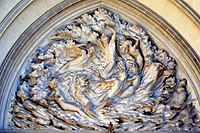Tympanum (architecture)

A tympanum (plural, tympana; from Greek and Latin words meaning "drum") is the semi-circular or triangular decorative wall surface over an entrance, door or window, which is bounded by a lintel and an arch.[1] It often contains pedimental sculpture or other imagery or ornaments.[2] Many architectural styles include this element.[3]
Alternatively, the tympanum may hold an inscription, or in modern times, a clock face.
History[]

In ancient Greek, Roman and Christian architecture, tympana of religious buildings often contain pedimental sculpture or mosaics with religious imagery.[5] A tympanum over a doorway is very often the most important, or only, location for monumental sculpture on the outside of a building. In classical architecture, and in classicising styles from the Renaissance onwards, major examples are usually triangular; in Romanesque architecture, tympana more often has a semi-circular shape, or that of a thinner slice from the top of a circle, and in Gothic architecture they have a more vertical shape, coming to a point at the top. These shapes naturally influence the typical compositions of any sculpture within the tympanum.
The upper portion of a gable when enclosed with a horizontal belt course, is also termed a tympanum.[6]
Bands of molding surrounding the tympanum are referred to as the archivolt.[7]
In medieval French architecture the tympanum is often supported by a decorated pillar called a trumeau.
Gallery[]

Ex Nihilo (Out of Nothing) by Frederick Hart, tympanum over center doors, Washington National Cathedral.

Tympanum of Kumari-ghar at Basantapur Durbar Square, Kathmandu.
Archivolts surrounding a tympanum of the west façade Strasbourg Cathedral, France.

The three tympana on the main façade of Notre-Dame de Paris, France.
Sculpted tympanum in Stralsund, Germany

Adoration of the Magi on a tympanum on Saint-Thiébaut Church, Thann, France.

Religious scene in a tympanum, Church San Lorenzo, Vicenza, Italy.
Scenes of the lives of Saint Peter and Mary, St Peter's, Vitoria-Gasteiz, Spain.

High-relief bronze tympanum of Writing, Thomas Jefferson Building, Washington, DC, USA.

Tympanum (showing the tree of life) and archivolt at Church of St Mary and St David, Kilpeck

Tympanum showing Christ in Majesty with four attendant angels, Rowlestone, Herefordshire, UK.
Romanesque Tympanum in the cathedral of Trier from about 1180

Tympanum of the Manila Cathedral in Intramuros, Philippines.
, Rio de Janeiro, clock with two figures

Lydiard House, Swindon, with heraldic sculpture, 1740s
See also[]
Citations[]
- ^ "Glossary - Tympanum". Architecture of the Indian Subcontinent. Retrieved 2007-06-28.
- ^ "Glossary of Medieval Art and Architecture - tympanum". University of Pittsburgh. Retrieved 2007-06-23.
- ^ "Illustrated Architecture Dictionary - Tympanum". www.buffaloah.com. Retrieved 2014-04-12.
- ^ Luebke, Wilhelm (1 January 1878). History of Sculpture from the Earliest Ages to the Present Time: Tr. by F.E. Bunnètt, Volume 2. Smith. p. 468. Retrieved 11 September 2021.
- ^ "Tympanum". www.OntarioArchitecture.com. Retrieved 2007-06-25.
- ^ One or more of the preceding sentences incorporates text from a publication now in the public domain: Chisholm, Hugh, ed. (1911). "Tympanon". Encyclopædia Britannica. 27 (11th ed.). Cambridge University Press. p. 498.
- ^ "Glossary of Medieval Art and Architecture - archivolt". University of Pittsburgh. Retrieved 2007-06-23.
External links[]
| Look up tympanum in Wiktionary, the free dictionary. |
| Wikimedia Commons has media related to tympanums. |
- Arches and vaults
- Architectural elements














